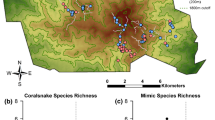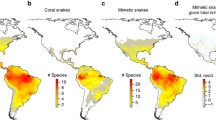Abstract
Batesian mimicry evolves when a palatable species, the “mimic,” resembles a dangerous species, the “model,” because both receive protection from predation. Yet, this protection should break down where the model is absent, because predators in such areas would not be under selection to avoid the model. Here, we test this prediction in a coral snake mimicry complex. We exposed plasticine replicas of milk snakes that closely mimic coral snakes to natural predators to determine if good mimetic milk snakes are preferentially attacked in allopatry with their model. Moreover, we evaluated whether attack rates on these replicas varied among three different allopatric regions that differed in the type of mimic found locally (i.e., good mimic, poor mimic, or no mimic). When all three regions were considered together, mimics were not preferentially attacked. When regions were analyzed separately, however, attacks on mimics were significantly greater than randomness only where good mimics were found. These variable levels of predation on good mimics might reflect frequency-dependent (i.e., apostatic) predation. In allopatric regions where good mimics are present, predators might have learned or evolved preferences for conspicuous, palatable prey that they encounter frequently. By contrast, in allopatric regions where good mimics are absent, predators might not have learned or evolved preferences for novel phenotypes. Thus, when predation is frequency-dependent, as long as good mimics are rare, they might not experience elevated levels of predation in allopatry with their model as predicted by the Batesian mimicry hypothesis.



Similar content being viewed by others
References
Allen JA (1988) Frequency-dependent selection by predators. Philos Trans R Soc Lond Ser B 319:485–503
Bates HW (1862) Contributions to an insect fauna of the Amazon valley. Lepidoptera: Heliconidae. Trans Linn Soc Lond 23:495–566
Brattstrom BH (1955) The coral snake “mimic” problem and protective coloration. Evolution 9:217–219
Brodie ED III (1993) Differential avoidance of coral snake banded patterns by free-ranging avian predators in Costa Rica. Evolution 47:227–235
Brodie ED III, Janzen FJ (1995) Experimental studies of coral snake mimicry: generalized avoidance of ringed snake patterns by free-ranging avian predators. Funct Ecol 9:186–190
Brodie ED III, Brodie ED Jr (2004) Venomous snake mimicry. In: Campbell JA, Lamar WW (eds) The venomous reptiles of the western hemisphere, vol II. Comstock, Ithaca, NY, pp 617–633
Clarke C, Sheppard PM (1975) The genetics of the mimetic butterfly Hypolimnas bolina (L). Philos Trans R Soc Lond Ser B 272:229–265
Conant R (1943) The milk snakes of the Atlantic coastal plain. Proc New Engl Zool Club 22:3–24
Conant R, Collins JT (1998) A field guide to reptiles and amphibians of eastern and central North America, 3rd edn. Houghton Mifflin, Boston, MA
Cope ED (1893) The color variation of the milk snake. Am Nat 27:1066–1071
Curio E (1976) The ethology of predation. Springer, Berlin Heidelberg New York
Edmunds M (1974) Defense in animals. A survey of anti-predator defenses. Longmans, London
Endler JA (1986) Natural selection in the wild. Princeton University Press, Princeton, NJ
Endler JA (1988) Frequency-dependent predation, crypsis and aposematic coloration. Philos Trans R Soc Lond Ser B 319:505–523
Endler JA (1991) Interactions between predators and prey. In: Krebs JR, Davies NB (eds) Behavioural ecology. An evolutionary approach, 3rd edn. Blackwell, London, pp 169–196
Gordon IJ, Smith DAS (1998) Body size and colour-pattern genetics in the polymorphic butterfly Hypolimnas misippus (L). Heredity 80:62–69
Greene HW, McDiarmid RY (1981) Coral snake mimicry: does it occur? Science 213:1207–1212
Greenwood JJD (1969) Apostatic selection and population density. Heredity 24:157–161
Hinman KE, Throop HL, Adams KL, Dake AJ, McLauchlan KK, McKone MJ (1997) Predation by free-ranging birds on partial coral snake mimics: the importance of ring width and color. Evolution 51:1011–1014
Holling CS (1965) The functional response of predators to prey density and its role in mimicry and population regulation. Mem Entomol Soc Can 45:1–60
Holling CS (1966) The functional response of invertebrate predators to prey density. Mem Entomol Soc Can 47:3–86
Kamil AC (1989) Studies of learning and memory in natural contexts: intergrating functional and mechanistic approaches to behaviour. In: Blanchard RJ, Brain P, Blanchard DC, Parmigiani S (eds) Ethoexperimental approaches to the study of behavior. Kluwer Academic, Dordrecht, pp 30–50
Koch PB, Behnecke B, Ffrench-Constant RH (2000) The molecular basis of melanism and mimicry in a swallowtail butterfly. Curr Biol 10:591–594
Madsen T (1987) Are juvenile grass snakes, Natrix natrix, aposematically colored? Oikos 48:265–267
Mallet J (2001) Mimicry: an interface between psychology and Evolution. Proc Natl Acad Sci USA 98:8928–8930
Mallet J, Joron M (1999) Evolution of diversity in warning color and mimicry: polymorphisms, shifting balance, and speciation. Ann Rev Ecolog Syst 30:201–233
Merilaita S (2006) Frequency-dependent predation and maintenance of prey polymorphism. J Evol Biol (in press). DOI 10.1111/j.1420-9101.2006.01137.x
Murdoch WW (1969) Switching in general predators: experiments of predator specificity and stability of prey populations. Ecol Monogr 39:335–354
Palmer WM, Braswell AL (1995) Reptiles of North Carolina. University of North Carolina Press, Chapel Hill, NC
Pfennig DW, Harcombe WR, Pfennig KS (2001) Frequency-dependent Batesian mimicry. Nature 410:323
Pough FH (1976) Multiple cryptic effects of crossbanded and ringed patterns of snakes. Copeia 1976:335–365
Prudic KL, Shapiro AM, Clayton NS (2002) Evaluating a putative mimetic relationship between two butterflies, Adelpha bredowii and Limenitis lorquini. Ecol Entomol 27:68–75
Roze JA (1996) Coral snakes of the Americas: biology, identification, and venoms. Krieger, Malabar, FL
Ruxton GD, Sherratt TN, Speed MP (2004) Avoiding attack: the Evolutionary ecology of crypsis, warning signals and mimicry. Oxford University Press, Oxford
Smith SM (1975) Innate recognition of coral snake pattern by a possible avian predator. Science 187:759–760
Smith SM (1977) Coral-snake pattern recognition and stimulus generalisation by naive great kiskadees (Aves: Tyrannidae). Nature 265:535–536
Thompson JN (2005) The geographic mosaic of coEvolution. University of Chicago Press, Chicago, IL
Waldbauer GP, Sternburg JG (1987) Experimental field demonstration that two aposematic butterfly color patterns do not confer protection against birds in Northern Michigan. Am Midl Nat 118:145–152
Wallace AR (1870) Contributions to the theory of natural selection. Macmillan, London
Wickler W (1968) Mimicry in plants and animals. McGraw-Hill, New York
Williams KL (1978) Systematics and natural history of the American milk snake, Lampropeltis triangulum. Milwaukee Public Museum Publications in Biology and Geology 2:1–258
Acknowledgements
We thank two anonymous referees for helpful comments on our paper. This research was supported by grants from the National Science Foundation to D. Pfennig and K. Pfennig.
Author information
Authors and Affiliations
Corresponding author
Additional information
Communicated by P. Weatherhead
Rights and permissions
About this article
Cite this article
Pfennig, D.W., Harper, G.R., Brumo, A.F. et al. Population differences in predation on Batesian mimics in allopatry with their model: selection against mimics is strongest when they are common. Behav Ecol Sociobiol 61, 505–511 (2007). https://doi.org/10.1007/s00265-006-0278-x
Received:
Revised:
Accepted:
Published:
Issue Date:
DOI: https://doi.org/10.1007/s00265-006-0278-x




